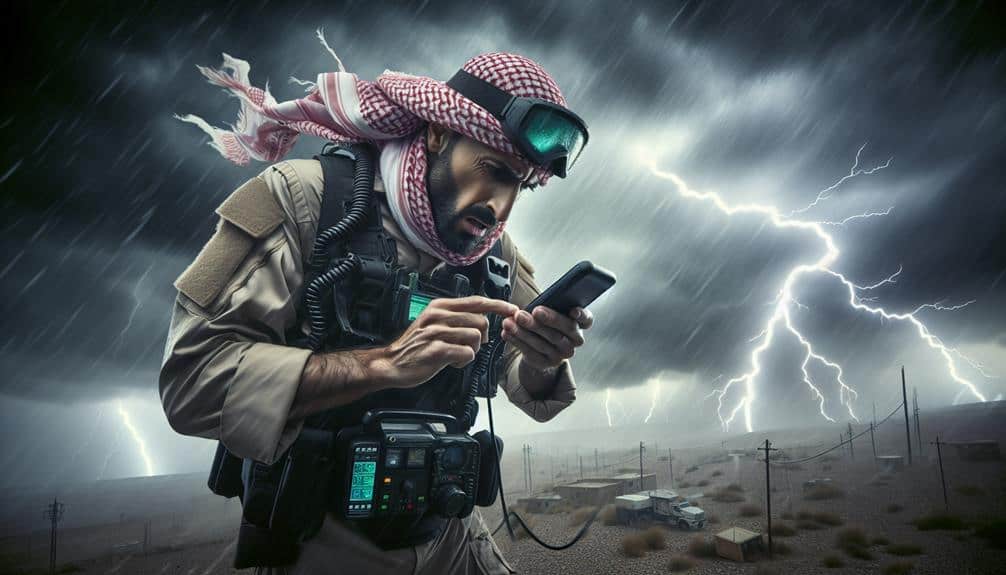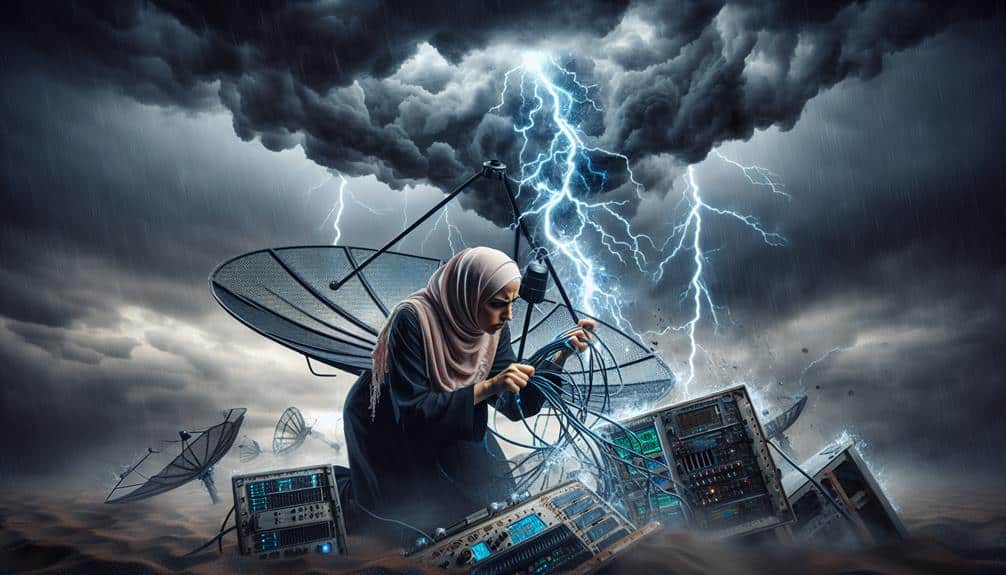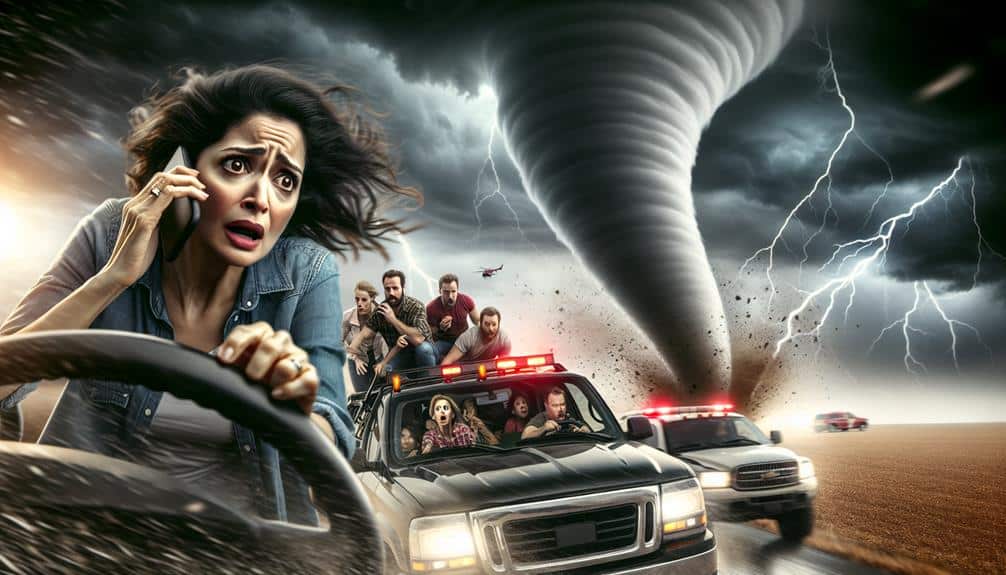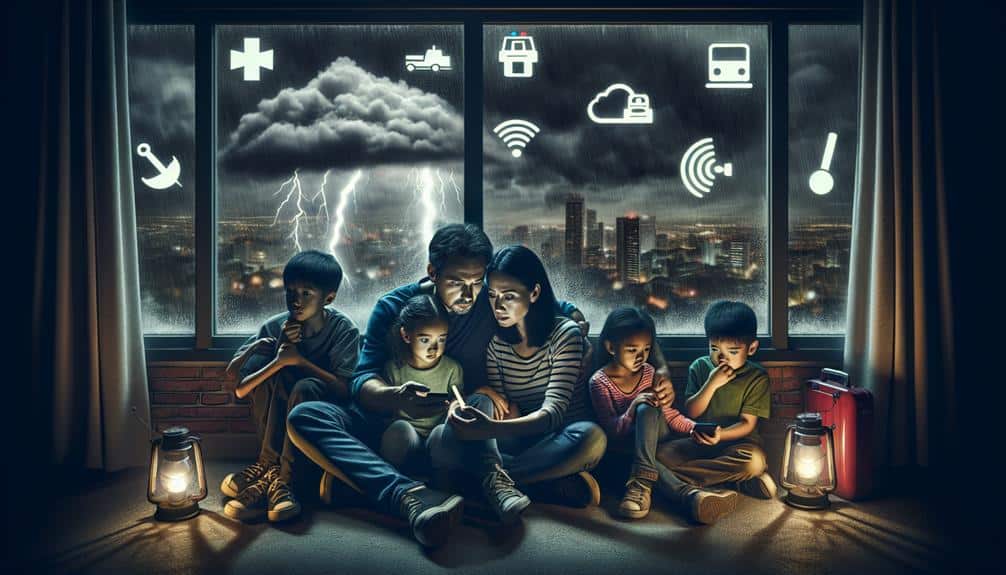In severe weather storm chasing, we address communication challenges by optimizing antenna placement and using portable signal boosters to counteract network coverage issues. Swift diagnostics and maintenance logs help us manage equipment malfunctions efficiently. For coordination, we establish clear protocols and utilize standardized terminology. Power management is essential, so we use energy-efficient devices and portable generators. To overcome language barriers, we depend on real-time translation tools and cross-cultural training. Data transmission delays are minimized through bandwidth optimization and data encryption. Exploring these tactics, we can greatly improve our communication reliability during storm chases.
Key Points
- Utilize satellite communication systems to ensure reliable connectivity in areas with limited network coverage.
- Implement portable signal boosters and strategically position antennas for optimal signal reception.
- Maintain detailed equipment logs and have emergency backup systems to manage equipment malfunctions.
- Develop clear communication protocols with first responders, using standardized terminology to avoid confusion.
Signal Interference Issues
One of the primary challenges we face in storm chasing is the notable signal interference caused by severe weather conditions. When powerful winds, heavy rain, and lightning disrupt communication, our ability to gather and share real-time data suffers.
To mitigate this, we need to focus on ideal antenna positioning. By strategically placing antennas at higher elevations and ensuring they're pointed in the direction of the strongest signal, we can maximize reception and minimize interference.
Another critical tool in our arsenal is the use of signal boosters. These devices amplify weak signals, enabling us to maintain communication with our team and access critical weather updates. When combined with proper antenna positioning, signal boosters can notably enhance our ability to stay connected, even in the most severe conditions.
Limited Network Coverage
Limited network coverage poses a significant challenge to storm chasers, as it hampers our ability to receive vital updates and maintain effective communication during severe weather events. In remote locations, where severe storms often occur, network signals are weak or non-existent. This limitation can jeopardize our safety and efficiency. To overcome these communication challenges, we need a multi-faceted approach.
- Network Optimization: Enhancing signal strength in remote locations through portable signal boosters can improve connectivity. These devices amplify existing signals, allowing us to stay connected even in thinly covered areas.
- Weather Resistant Devices: Utilizing durable, weather resistant devices ensures our equipment remains operational under extreme conditions. These devices are designed to withstand harsh weather, maintaining functionality when we need it most.
- Satellite Communication: Integrating satellite phones or satellite internet can provide a reliable communication channel independent of terrestrial networks. This guarantees continuous connectivity, essential for real-time updates and coordination.
- Pre-Deployment Planning: Conducting thorough pre-chase planning to identify areas with known coverage gaps allows us to strategize alternative communication methods and routes, minimizing unexpected downtime.
Equipment Malfunctions
When equipment malfunctions during a severe weather chase, our ability to gather accurate data and communicate effectively is severely compromised. This scenario demands immediate attention to repair procedures.
First, we need to perform a swift diagnostic to pinpoint the malfunction. Knowing our gear inside out is vital; it allows us to execute prompt repairs. Keeping a detailed log of equipment maintenance also helps in preemptively identifying potential issues.
In the heat of a storm, having an emergency backup system is non-negotiable. Whether it's a secondary communication device or spare parts for critical instruments, redundancy is our safety net. These backups should be tested regularly and ready for deployment at a moment's notice.
Communication troubleshooting becomes essential when primary systems fail. We must be adept at switching to alternative channels and using manual protocols if automated systems go down. Clear, predefined troubleshooting steps help us restore functionality quickly.
Our commitment to meticulous equipment maintenance ensures we mitigate the risk of malfunctions. Regular checks and updates are our first line of defense against technical failures, enabling us to maintain the freedom needed to chase storms effectively and safely.
Coordination With First Responders
In storm chasing, our coordination with first responders is essential for ensuring safety and efficiency.
We must establish clear communication protocols and share real-time data to enhance situational awareness.
Clear Communication Protocols
Effective coordination with first responders relies on establishing clear communication protocols that guarantee timely and accurate information exchange. In storm chasing, our ability to relay critical data can mean the difference between life and death.
To ensure efficient team coordination and effective emergency procedures, we must adhere to a structured communication framework.
Here are four key components that underpin our communication protocols:
- Standardized Terminology: Using common language ensures everyone understands the situation without ambiguity. This reduces miscommunication and enhances clarity.
- Designated Communication Channels: Assign specific radio frequencies and digital channels for different types of information. This prevents congestion and ensures that crucial messages get through.
- Regular Status Updates: Implement a routine for periodic check-ins. By updating each other at predetermined intervals, we maintain situational awareness and promptly address any emerging issues.
- Emergency Signal Codes: Predefined codes for various emergency scenarios streamline the response. First responders can react swiftly, knowing exactly what type of assistance is needed.
Real-time Data Sharing
To improve our coordination with first responders, we must leverage real-time data sharing to provide immediate and actionable insights. By utilizing advanced data encryption protocols, we guarantee that the sensitive information we transmit remains secure and inaccessible to unauthorized parties. This protection is vital as we exchange high-stakes data about storm trajectories, wind speeds, and potential impact zones.
Remote access capabilities further streamline our communication efforts. First responders can access our data from any location, enabling them to make quick, informed decisions without the need for physical presence. This flexibility not only speeds up response times but also allows for dynamic adjustments as weather conditions evolve.
Moreover, integrating our data systems with those used by emergency services enhances the quality and relevance of the information we share. By standardizing data formats and ensuring compatibility, we reduce the risk of miscommunication. This seamless data flow is crucial for maintaining situational awareness and executing timely interventions.
In our pursuit of freedom, we acknowledge the significance of robust, secure, and accessible real-time data sharing. It's a key component that empowers both storm chasers and first responders to act swiftly and effectively, mitigating the risks posed by severe weather conditions.
Emergency Response Synchronization
Synchronizing our emergency response efforts with first responders is crucial for minimizing the impact of severe weather events. By streamlining our communication channels and ensuring precise coordination, we can enhance both response timing and operational efficiency.
Here's how we can achieve this:
1. Establish Clear Protocols:
Defining specific roles and responsibilities for each team member and first responder ensures everyone knows their tasks, reducing confusion and overlap.
2. Use Advanced Communication Tools:
Leveraging technology like real-time GPS tracking and encrypted communication apps helps us share critical information quickly and securely.
3. Regular Training Drills:
Conducting joint training exercises allows our team to practice working seamlessly with first responders, honing our skills and improving team coordination.
4. Centralized Command Center:
Setting up a unified command center facilitates better decision-making and resource allocation by providing a single point of contact for all emergency response activities.
Battery Life Concerns

When storm chasing, we must prioritize efficient power management to guarantee continuous communication.
Backup charging solutions and battery conservation techniques are critical in maintaining our devices' functionality during prolonged operations.
Let's analyze how these strategies can optimize our battery life in severe weather conditions.
Efficient Power Management
In the field of storm chasing, our ability to manage power efficiently is critical to making sure that all electronic devices remain operational throughout the mission. Effective power management revolves around energy conservation and the exploration of charging alternatives. By adopting strategic approaches, we can maximize battery life and maintain communication in the most volatile conditions.
To achieve this, we should focus on the following key strategies:
- Prioritize Device Usage: Only essential devices should be active. Non-essential gadgets can be powered down to save energy.
- Optimize Settings: Adjusting screen brightness, disabling non-critical apps, and using power-saving modes can greatly extend battery life.
- Scheduled Charging: Plan charging times during low-activity periods to make certain batteries are full when needed most.
- Energy-Efficient Equipment: Utilize devices designed to consume less power, such as low-energy radios and efficient laptops.
Backup Charging Solutions
To complement our energy conservation strategies, we must incorporate strong backup charging solutions to guarantee uninterrupted power supply during extended storm chasing missions.
First, let's consider solar panels. These provide a sustainable and portable energy source ideal for the unpredictable nature of storm chasing. Modern foldable solar panels are lightweight and efficient, allowing us to harness solar energy even in low-light conditions. However, their performance is dependent on weather conditions, which can be a limitation during severe storms.
Next, portable generators offer a more consistent and reliable power source. Equipped with inverter technology, these generators provide clean power, essential for sensitive electronic equipment. They can run on various fuels, including gasoline and propane, giving us the flexibility to adapt to different scenarios. The downside is their bulk and noise, which can be cumbersome in the field and potentially impede stealth and mobility.
Combining these solutions creates a strong system. Solar panels can charge our devices during daylight, while portable generators can serve as a dependable backup during cloudy conditions or nighttime. By integrating these technologies, we guarantee our communication equipment remains operational, paving the way for successful and safe storm chasing missions.
Battery Conservation Techniques
Effective battery conservation techniques are essential to ensure our devices remain functional throughout the entire storm chasing mission. To maximize performance, we must adopt methods that enhance battery life, particularly when immediate recharging options are limited.
Here's how we can achieve that:
- Disable Non-Essential Features: Turning off Wi-Fi, Bluetooth, and background apps can greatly reduce battery drain. Only critical communications and applications should remain active.
- Use Power Banks: High-capacity power banks serve as reliable backup power sources. They provide multiple recharges and are compact enough to be carried easily.
- Solar Charging: Utilizing portable solar chargers can be a game-changer, especially in remote areas. These devices harness sunlight to replenish our batteries, making sure we don't rely solely on electrical outlets.
- Battery-Saving Settings: Enabling power-saving modes on our devices can extend battery life. These settings dim screens, reduce processing speeds, and limit background activity.
Language Barriers
Managing language barriers during storm chasing requires strategic planning and real-time translation tools to guarantee clear and accurate communication. We must consider cultural differences that may impact how information is conveyed and understood.
It's vital to have robust translation services integrated into our communication systems. These tools should support multiple languages and offer rapid, context-aware translations to minimize misunderstandings.
In practice, our team utilizes advanced translation software that can interpret technical jargon specific to meteorology. This ensures that important information, such as wind speeds and storm trajectories, is accurately relayed, regardless of the native language of the team members or local contacts.
Additionally, pre-arranged protocols for emergency communication can help reduce the risks posed by language barriers. We also invest in cross-cultural training for our team. Understanding cultural differences helps us adapt our communication styles to be more effective and respectful.
This is particularly important when collaborating with local authorities and communities. By incorporating these strategies, we improve our operational efficiency and guarantee that everyone involved has the freedom to act swiftly and correctly in life-threatening weather conditions.
Effective management of language barriers is therefore vital to our storm chasing endeavors, optimizing both safety and performance.
Data Transmission Delays

Data transmission delays pose a significant challenge in storm chasing, impacting the timeliness and accuracy of critical information relay. When we're out in the field, every second counts. Delays can impede our ability to make swift decisions, potentially compromising safety and data integrity. Satellite communication is one of our primary methods for transmitting data, but it's not without its issues.
Here are four major factors contributing to these delays:
- Bandwidth Limitations: Satellite communication systems often have restricted bandwidth, causing bottlenecks when transmitting large datasets.
- Data Encryption: While essential for securing our transmissions, data encryption can introduce latency, as the data must be encrypted before sending and decrypted upon receipt.
- Signal Interference: Severe weather conditions can disrupt satellite signals, leading to interruptions and delays in data transmission.
- Latency in Relays: Data often needs to pass through multiple relays before reaching its destination, each step adding potential delay.
We must continually refine our systems to minimize these delays. By optimizing our data encryption processes and exploring alternative communication methods, we can guarantee more timely and accurate information relay, granting us the freedom to make better-informed decisions in real-time.
Frequently Asked Questions
What Personal Safety Measures Should Storm Chasers Take During Severe Weather Events?
We should strictly follow emergency protocols and guarantee we have proper equipment. This includes weather radios, GPS, and first-aid kits. Adhering to these measures maximizes our safety while allowing us the freedom to explore severe weather.
How Can Storm Chasers Effectively Document Their Findings?
We can document our findings by using drones to capture high-resolution images and videos. These visuals aid in data visualization, facilitating collaborative efforts among storm chasers, meteorologists, and researchers to analyze and predict severe weather patterns.
What Are the Best Practices for Real-Time Data Analysis in the Field?
For real-time data analysis in the field, we prioritize accurate data interpretation and robust field communication. We use mobile tech for instant updates and coordinate via secure channels to guarantee precise, timely information sharing and decision-making.
How Do Storm Chasers Stay Informed About Changing Weather Conditions?
We stay informed about changing weather conditions through satellite imagery, radio communication, and mobile apps. We analyze real-time data, monitor weather updates, and communicate with fellow chasers to make sure we're always ahead of the storm.
What Training Is Required to Become a Professional Storm Chaser?
To become professional storm chasers, we must master safety protocols, field equipment handling, and navigation skills. In-depth meteorology knowledge is essential. Rigorous training guarantees we can navigate severe weather safely while accurately observing and documenting storm phenomena.


